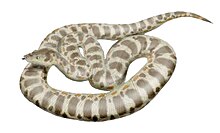泰坦巨蟒属
泰坦蚺属(学名:Titanoboa,意即“极大的蚺蛇”)[1]是一个生活在古新世(约 6,000 至 5,800 万年前)哥伦比亚东北部瓜希拉省的无毒、肉食性蚺类。[2]已知的唯一种塞雷洪泰坦蚺(T. cerrejonensis)也是已知最大的蛇。[2]把它石化的脊椎骨与现代蛇比较,研究人员估计其最大全长14米(46英尺),体重超过1,100公斤(2,400磅),身体最粗处厚达1米(3.3英尺)。[2]它可能是以鳄鱼为食的。[3]
| 泰坦蚺属 化石时期:中 - 晚古新世
| |
|---|---|

| |
| 泰坦蚺复原图 | |
| 科学分类 | |
| 界: | 动物界 Animalia |
| 门: | 脊索动物门 Chordata |
| 纲: | 爬行纲 Reptilia |
| 目: | 有鳞目 Squamata |
| 亚目: | 蛇亚目 Serpentes |
| 科: | 蚺科 Boidae |
| 亚科: | 蚺亚科 Boinae |
| 属: | †泰坦蚺属 Titanoboa Head et al. 2009 |
| 种 | |
| |
发现
编辑二十八条巨蚺的化石是在2009年在哥伦比亚北部的塞雷洪煤矿被发现的。[1][2]在此以前,在南美洲昔日的热带地区很少有古新世的脊椎动物被发现。[4]
此种是由佛罗里达大学研究脊椎动物的古生物学家约纳森·希洛克(Jonathan Bloch)和巴拿马史密森尼热带研究所的古植物学家卡洛斯·哈拉米约(Carlos Jaramillo)率领的国际科学考察队伍发现的。[5]
体型与温度的关系
编辑由于蛇是变温动物,这项发现也暗示了:当时的其生活的热带地区比研究人员原先估计的更温暖,平均气温为 32℃(90°F)。[1][2][6][7]只有这样的气候才能让蛇长得这么大。[8][9]而目前当地的年平均气温为 28℃。[10]
然而,一些研究人员不同意上述估计。例如,2009年在“自然”杂志上的研究,应用上述的数学模型在温带澳大利亚古蜥蜴化石,预测目前生活在热带地区的蜥蜴应该能够达到33英尺,所以显然不是这样的。 [11]
另一个在同一期杂志上马克·丹尼(生物力学方面的专家)发表的批评指出,这种蛇是如此之大并且产生这么多的代谢热量,环境温度必须比目前的温度低四到六度,否则蛇会有过热的危险。[12]
体型比较
编辑二十八条蛇中最大的八条重约 2,500 磅(1,136 公斤),体长 12—15 米(37—50 英尺)。而现存最大的蛇,包括长约 7.5 米(24 英尺)的森蚺(最重的蛇)[13]和长约 9.9 米(32.5英尺)的网纹蟒(最长的蛇)。[3]而现存最小的蛇,卡拉细盲蛇,身长只有10 公分(4 英寸)。[14]此前最长的化石蛇,是非洲巨蟒,出土自埃及,长 10 米。[15]
参考文献
编辑- ^ 1.0 1.1 1.2 Head, Jason J.; Jonathan I. Bloch, Alexander K. Hastings, Jason R. Bourque, Edwin A. Cadena, Fabiany A. Herrera, P. David Polly, and Carlos A. Jaramillo. Giant boid snake from the paleocene neotropics reveals hotr past equatorial temperatures.. Nature: 715–718. [2009-02-05]. (原始内容存档于2017-03-07).
- ^ 2.0 2.1 2.2 2.3 2.4 Kwok, Roberta. Scientists find world's biggest snake. Nature. 4 February 2009 [4 February 2009]. (原始内容存档于2019-09-07).
- ^ 3.0 3.1 CTV: Ancient, gargantuan snakes ate crocs for breakfast. CTV电视网. February 4, 2009 [4 February 2009]. (原始内容存档于2009-02-06).
- ^ Maugh II, Thomas H. Fossil of 43-foot super snake Titanoboa found in Colombia. 洛杉矶时报. 4 February 2009 [4 February 2009]. (原始内容存档于2009-02-06).
- ^ At 2,500 Pounds And 43 Feet, Prehistoric Snake Is Largest On Record. 科学日报. February 4, 2009 [4 February 2009]. (原始内容存档于2017-08-11).
- ^ Joyce, Christopher. 1-Ton Snakes Once Slithered In The Tropics. 全国公共广播电台. 5 February 2009 [5 February 2009]. (原始内容存档于2019-01-07).
- ^ Science Direct: Climate model sensitivity to atmospheric CO2 levels in the Early–Middle Paleogene. [2009-02-06]. (原始内容存档于2009-02-08).
- ^ The Royal Society: Gigantism, temperature and metabolic rate in terrestrial poikilotherms. [2009-02-06]. (原始内容存档于2020-02-02).
- ^ AP: Video of Titanoboa. [2009-02-06]. (原始内容存档于2009-02-08).
- ^ 南美出土13米长巨型蚺蛇化石. BBC中文网. 2009年2月4日 [2009年2月6日]. (原始内容存档于2009年2月7日).
- ^ J. M. Kale Sniderman. Biased reptilian palaeothermometer?. [2009-07-30]. (原始内容存档于2018-09-30).
- ^ Mark W. Denny1, Brent L. Lockwood1 & George N. Somero. Can the giant snake predict palaeoclimate?. [2009-07-30]. (原始内容存档于2009-08-03).
- ^ Mehrtens JM. 1987. Living Snakes of the World in Color. New York: Sterling Publishers. 480 pp. ISBN 0-8069-6460-X.
- ^ S. Blair Hedges. At the lower size limit in snakes: two new species of threadsnakes (Squamata: Leptotyphlopidae: Leptotyphlops) from the Lesser Antilles (PDF). Zootaxa. August 4, 2008, 1841: 1–30 [2008-08-04]. (原始内容存档 (PDF)于2019-07-24).
- ^ 巨蛇化石残骸在哥伦比亚发现. 美国之音. 2009年2月5日 [2009-02-06]. (原始内容存档于2009-02-08).
外部链接
编辑- 研究显示一种远古巨蛇可能是迄今最长蛇类. 新华社. 2009年2月5日 [2009年2月6日]. (原始内容存档于2009年2月8日).